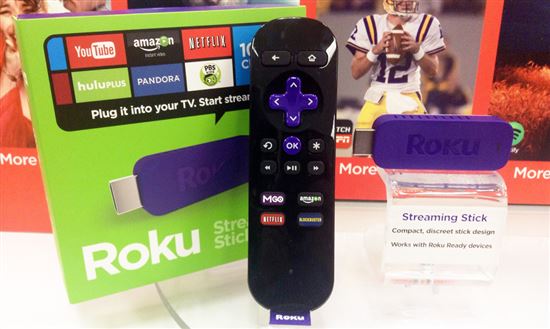How to Invest in Roku
Roku is one of the most popular streaming devices. Is it right for your portfolio? Learn how to invest in Roku with as little as $1.
 |
| © Mike Mozart (CC BY 2.0) via Flickr |
Deposit $100 and Get $10 from eToro USA LLC
- Sign up for an eToro account
- Deposit $100
J.P. Morgan Self-Directed Investing - Get Up to $700
- Get up to $700 when you open and fund a J.P. Morgan Self-Directed Investing account with qualifying new money.
- $700 when you fund with $250,000 or more
- $325 when you fund with $100,000-$249,999
- $150 when you fund with $25,000-$99,999
- $50 when you fund with $5,000-$24,999
- Get unlimited commission-free online stock, ETF, fixed income, and options trades when you open an account.
- $0 Online Commission trades
- Choose an account that's right for you: General Investing, Traditional IRA or Roth IRA.
- Access our secure, easy-to-use trading experience online or through the Chase Mobile® app.
- Our powerful tools and resources are built to help you take control of your investments.
INVESTMENT AND INSURANCE PRODUCTS ARE:
Founded in 2002, Roku has transformed the way we watch TV with its affordable digital streaming devices. It currently has 40 million active monthly users. Roku went public on September 28, 2017, on NASDAQ (ticker symbol ROKU). Despite some volatility, Roku stock has generated impressive returns.
Luckily these days, the barrier to the stock market has never been so low. There are lots of investment apps that allow you to buy stocks with just a few dollars.
Here's a step-by-step guide of how to buy Roku stock. We'll also talk about some factors to consider before investing in a company.
1. Find the Right Online Brokerage
Roku stock is listed on the NASDAQ Stock Exchange. Make sure the brokerage you use has access to this exchange. Just about all U.S.-based brokerages offer access to the NASDAQ market.
When choosing a stockbroker, consider these factors:
- Minimum opening deposit
- Commission fees and other fees
- Level of service, account types, and other products
- Does it support fractional shares?
- Will you be trading actively or buy-and-hold?
- How much research do you need?
Luckily, most major brokerages have eliminated trading fees. However, some apps may have a small monthly fee for using the service.
If you're a beginner without a lot of money to invest, fractional shares will be important. This lets you purchase just a tiny share of a stock. Not all brokers support this.
 |  |  | |
| Visit Site | Visit Site | Visit Site | |
Robinhood | M1 Finance | Webull | |
|---|---|---|---|
Get a Free Stock (worth between $5 and $200) - | Commission Free Stock Trading - | 20 Free Fractional Shares - | |
Benefits and Features | |||
| Stock Trading | |||
| Minimum Deposit | $100 ($500 for IRAs, $5,000 for Trust Account) | ||
| Fractional Shares | |||
| Good For | DIY investing with passive portfolio management | Experienced investors; Active traders | |
| Visit Site | Visit Site | Visit Site | |
Robinhood: Pricing information from published websites as of 04/18/2020. M1 Finance: Pricing information from published website as of 12/26/2023. | |||
Keep reading for our top recommended brokers to buy Roku stock.
2. Open and Fund Your Account
After you've chosen your brokerage, it's time to open an account. Usually, you need to provide your name, address, contact info, and Social Security number. There is no credit check for a regular brokerage account.
Next, you will need to deposit funds into your new account in order to start trading. To do so, you will need to link a bank account. Then you can fund your account via electronic transfer from your bank. This usually takes 3-5 business days to clear.
- Taxable: A general purpose investment account
- Joint: An account shared between two individuals
- Retirement (includes Traditional and Roth IRA)
- 529 College Savings
- Custodial: An account set up for a minor
3. Purchase Roku Stock
Lastly, all you have to do is purchase Roku stock. Roku is found under the ticker symbol ROKU. Just search for ROKU in your brokerage platform and input how much you'd like to buy.
There are two types of orders you can execute to place your trade:
- Market order: Execute the transaction now at the current market price.
- Limit order: Set a specific price at which you wish to buy. This gives investors more control. But if the stock never hits the price you set, the trade will never be executed.
For brokerages that offer fractional shares, you can purchase just a tiny piece if you don't have enough money for a full share. This allows you to still be able to invest in Roku even if you only have $10 to invest.
Some brokerages don't support fractional shares. In that case, you will need to have enough money for at least one full share.
Is Roku Stock Right for You?
Don't make the buy-or-not decision purely based on the stock's current price. Instead, consider if Roku is right for your goals and risk tolerance. This comes down to what kind of investor you are.
Are you looking for passive income through cash dividends? Roku has never paid dividends and has no plans to do so in the foreseeable future. Is this something you want?
How much risk can you afford? Remember that stocks can be volatile, some sectors more so than others. Despite Roku's impressive gains since its public debut, it has been quite volatile. So it's best if you can commit to holding your investment for a few years to ride out any downturns.
Pros and Cons of Buying Roku Stock
Pros:
- Strong user growth and increased streaming hours in the past year
- Selling ads on the platform allows it to bring in a lot of revenue
- Plans for international expansion underway
Cons:
- Competition from Amazon Fire Stick and Apple TV
- Not yet profitable nor has it shown consistent cash flow
How to Analyze Roku's Financials
Before investing in a company, it's smart to do some research. This helps you form a more informed decision on whether the stock is a good buy or not.
It's also smart to take a look at the company's competitors. Roku's competitors include Amazon and Apple, both of which offer their own streaming devices, in addition to lots of other products and services. It also competes with traditional TV providers like Comcast, which offers its own streaming box. It's important to compare Roku's financials and growth against the competition.
Here are some things you can look at to evaluate a stock. Most brokerages will provide a summary of the main numbers for each company, as well as a chart of its historical performance.
- Annual report: Details the company's financial performance, including income and cash flow statements, revenue, and expenses. Most companies will have this for free on their website.
- Quarterly financial statements
- Profit margin (%): How much profit the company gains for every dollar in sales. The higher number, the better.
- Return on equity (%): How much profit the company generates with each $1 of the shareholders' money. The higher number, the better.
- Price-earnings ratio (P/E): The company's current stock share price to the company's average earnings per share. Usually, a higher P/E ratio means investors are expecting higher growth.
- Debt-equity ratio (D/E): How much debt the company has compared to its shareholder equity. Usually, a higher ratio means more risk to investors. But you have to consider the industry.
How to Reduce Risk
Any stock investment will carry some risk, even if you do your research carefully. The best way to minimize risk is by diversifying your portfolio.
In other words, don't put all your money in just Roku stock. Instead, spread out your investments into many different stocks. That way, if Roku's price falls, you'll still have others to carry you through. It's recommended you have 10-20 stocks in your portfolio for diversification.
It's also smart to invest in stocks in different sectors. Roku is in the Communication Services sector, which may experience more volatility. To spread out risk, also buy shares of stocks in other sectors like Financial, Healthcare, Technology, etc.
An easy way to reduce risk is by investing in index funds. These funds follow a specific market index (like the S&P 500). One fund contains hundreds of securities, so you're instantly diversified. You can have the majority of your portfolio in index funds, and then just pick a few specific companies to invest in.
Best Brokerages to Invest in Roku
Here are some of our top recommended brokerages to buy Roku shares. All these brokerages have no trading commissions.
Robinhood
Robinhood is one of the most popular investment apps for beginners. It has no minimum to get started. A big benefit is that it supports fractional shares, allowing you to invest in stocks with as little as just $1.
M1 Finance
M1 Finance is a unique hybrid self-directed brokerage and automated investing. You choose your own stocks and build your own portfolio. Then M1 will automate your strategy. It also supports fractional shares. The minimum to start is $100.
Stash Invest
Stash Invest is designed for new investors who need a little handholding. It guides you to pick stocks aligned with your goals and risk tolerance, but you can also choose your own stocks. You can purchase fractional shares. There is a monthly fee starting at $3/mo.
Webull
Webull also has no trading fees or minimum investment. It offers better research tools and analytics for more experienced investors. It's also a good choice for active traders with free extended trading hours. Webull offers fractional shares for as little as $5.
Fidelity
Fidelity is a great choice if you're looking for a full-service brokerage with a wide variety of account types and other investment products. There is no account minimum. Fidelity also offers fractional shares from as little as $1.
Bottom Line
Before investing in any stock, it's smart to do research on the company to see if it's a good fit for your portfolio. After that, it's just a matter of finding the right brokerage for your needs. Remember to regularly review your investments to see how they're performing and if you need to make any adjustments to your portfolio.
Anna G is a research director at CreditDonkey, a personal finance comparison and reviews website. Write to Anna G at feedback@creditdonkey.com. Follow us on Twitter and Facebook for our latest posts.
Note: This website is made possible through financial relationships with some of the products and services mentioned on this site. We may receive compensation if you shop through links in our content. You do not have to use our links, but you help support CreditDonkey if you do.
|
|
|






